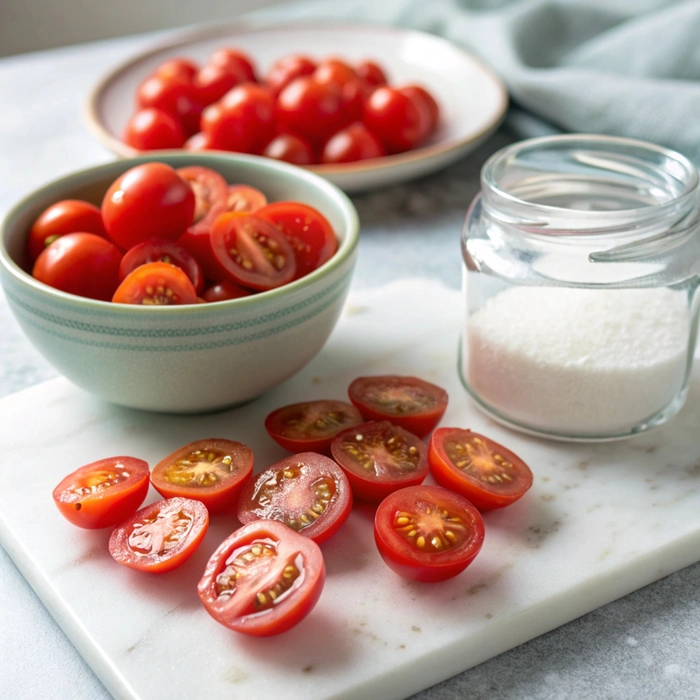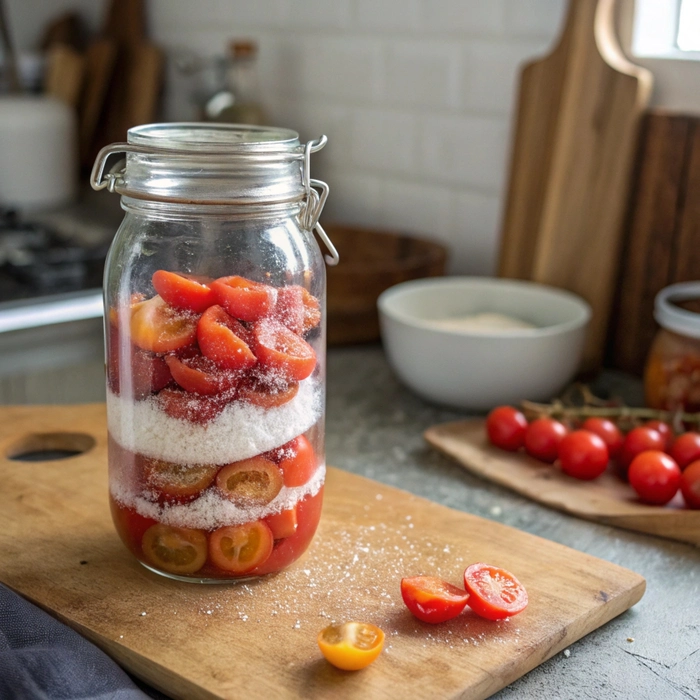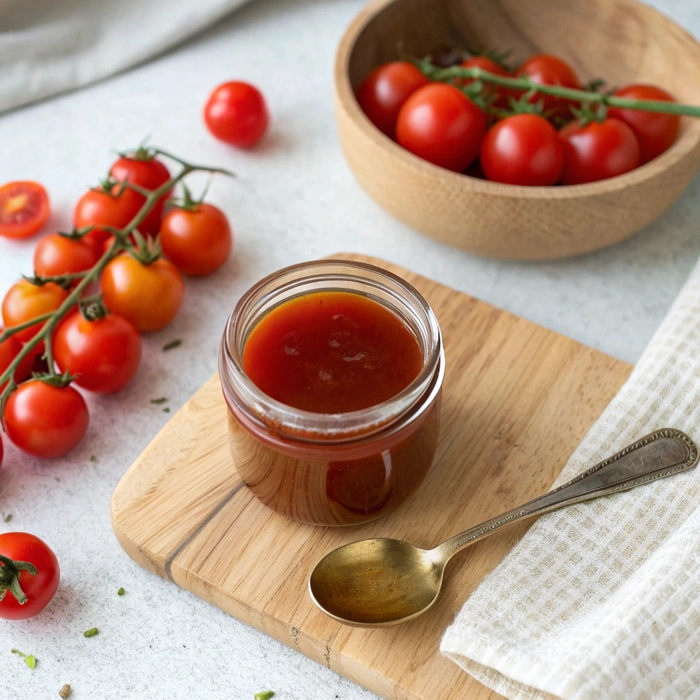I never expected my everyday cherry tomatoes to transform into something magical, but that’s what happened the first time I made Tomato Cheong Syrup. This Korean-inspired preserve layers tomatoes with sugar until the juices release into a bright, sweet-tangy syrup that’s both nostalgic and modern. In this article, we’ll explore the story behind this syrup, how to make it at home, the endless ways to use it, and the best tips for storage. Whether you drizzle it over yogurt, shake it into cocktails, or stir it into a savory glaze, Tomato Cheong Syrup adds a new dimension of flavor to everyday dishes.
A Flavorful Discovery of Tomato Cheong Syrup
From Cherry Tomatoes to Blush-Colored Syrup
My introduction to Tomato Cheong Syrup happened during a summer overflowing with ripe tomatoes. Instead of letting them spoil, I borrowed from Korean tradition and layered halved cherry tomatoes with equal sugar by weight. After a few days, I discovered a syrup that tasted like summer distilled into liquid form—sweet, tangy, and layered with natural umami. Unlike traditional jams or jellies, this syrup didn’t require cooking, which kept the flavor incredibly fresh and bright. It became my secret ingredient for iced teas and breakfast bowls.
What Makes Tomato Cheong Syrup Unique
What sets this syrup apart is the harmony it creates. Tomatoes bring acidity and a savory undertone, while sugar balances with sweetness. Together, they form a syrup that’s versatile across both sweet and savory cooking. This balance makes it different from classic simple syrups made only with sugar and water. With just two ingredients, you unlock a pantry staple that can elevate smoothies, cocktails, or even roasted vegetable dishes. Recipes like the Air Fryer Baked Apples or the Oat Milk Matcha Latte pair beautifully with a drizzle of Tomato Cheong Syrup for added depth.
PrintTomato Cheong Syrup – Sweet, Tangy, and Freshly Homemade
Sweet and tangy Tomato Cheong Syrup made with just cherry tomatoes and sugar, perfect for drinks and dishes.
- Prep Time: 10 minutes
- Cook Time: 0 minutes
- Total Time: 3–5 days
- Yield: 2 cups syrup
- Category: Condiment
- Method: No-cook
- Cuisine: Korean-inspired
- Diet: Vegetarian
Ingredients
2 cups cherry tomatoes, halved
2 cups granulated sugar
Optional: 2 basil leaves or 1 tbsp lemon juice
Instructions
1. Wash and halve cherry tomatoes.
2. Weigh and layer equal amounts of tomatoes and sugar in a sterilized glass jar.
3. Seal and leave at room temperature, stirring once daily.
4. After 3–5 days, strain syrup if desired and refrigerate.
5. Use syrup in drinks, desserts, or savory glazes.
Notes
Keep refrigerated after 3–5 days.
Strain solids for longer shelf life.
Experiment with herbs like basil or spices like ginger.
How to Make Tomato Cheong Syrup with Simplicity and Flair
The Traditional Cheong Method Meets Tomatoes
At its core, Tomato Cheong Syrup follows the classic cheong technique: equal parts fruit and sugar, left to macerate. For tomatoes, select ripe cherry or grape varieties for concentrated sweetness. Wash and halve them, then weigh and layer with sugar in a sterilized glass jar. The sugar begins to draw out moisture, forming syrup in as little as 24 hours. Stir daily with a clean spoon, and within three to five days, you’ll have a bright, flavorful syrup ready to enjoy. Unlike cooked syrups, this raw process preserves vitamins and a natural tomato tang.
Optional Flavor Boosters
Though the base recipe is simple, you can add flair by including complementary flavors. Fresh basil leaves add a subtle herbal note, while lemon juice brightens acidity. A touch of ginger or even a cinnamon stick can give the syrup a warming dimension. This flexibility allows you to tailor the syrup to your taste or to pair with recipes like the Protein Coffee Smoothie or Air Fryer Caramelized Peaches. A small adjustment turns a basic cheong into a signature kitchen creation.

Uses and Pairings That Surprise and Delight
From Coffee to Cocktails
One of the best parts about Tomato Cheong Syrup is how many ways you can use it. Stir it into sparkling water for a refreshing soda, or mix with cold brew for a unique tomato-sweetened coffee. It shines in cocktails too—imagine it in a gin spritz or a Bloody Mary for a fresh twist. The natural acidity balances alcohol beautifully, making it an excellent syrup for creative mixology. Pairing it with light summer drinks turns an ordinary gathering into something memorable.
Savory Meets Sweet
Beyond drinks, this syrup enhances savory dishes. Use it as a glaze for roasted vegetables or grilled salmon, where its sweet-tart notes cut through richness. Whisk it into vinaigrettes for salads or drizzle it over fresh mozzarella with basil for a modern Caprese. You’ll find it complements dishes like the Air Fryer Zucchini Fritters or Cottage Cheese Flatbread Air Fryer, bringing brightness to wholesome meals. This versatility makes Tomato Cheong Syrup more than just a sweetener—it’s a flavor enhancer across the board.
Storage, Shelf Stability, and Safety Tips
How Long Does Tomato Cheong Syrup Last?
When it comes to storage, Tomato Cheong Syrup requires attention. Because it’s uncooked, it’s best kept refrigerated. Properly sealed, it stays fresh for up to two weeks. If you want longer shelf life, strain out solids after five days to slow fermentation. Some people freeze the syrup in ice cube trays for quick single-serve portions, extending its usability for months. Unlike commercial syrups, this homemade version doesn’t contain preservatives, so mindful storage ensures quality.
Avoiding Fermentation Gone Wild
Fermentation is natural in cheong, but there’s a fine line between desirable flavor and spoilage. Signs of unwanted fermentation include bubbling, sour off-smells, or mold growth. Always use sterilized jars, clean spoons, and equal sugar ratios to keep the syrup safe. If handled properly, Tomato Cheong Syrup rewards you with rich flavor without the risk. It’s a good practice to label jars with dates and monitor regularly, just as you would with homemade pickles or ferments. Recipes like Air Fryer Date S’mores or Sweet Rice Mini Bundt Cake benefit when paired with a well-kept syrup.
What Is Tomato Cheong Syrup?
Tomato Cheong Syrup is a traditional Korean-inspired preserve made by combining ripe tomatoes with sugar, then allowing the mixture to ferment naturally. The word cheong translates to “syrup” or “preserve,” and it’s often used for fruits like plums, yuzu, or strawberries.
When made with tomatoes, the syrup develops a delicate balance between sweet and savory, with a subtle tang that makes it incredibly versatile. Unlike standard tomato sauces or jams, Tomato Cheong Syrup is not cooked but rather slowly infused over days or weeks, preserving the freshness of the fruit while enhancing its natural umami notes. This process creates a unique syrup that can be enjoyed in drinks, drizzled over desserts, or even used in marinades. Many home cooks are discovering Tomato Cheong Syrup as a way to transform simple tomatoes into a gourmet ingredient with both culinary and cultural value.

Health Benefits of Tomato Cheong Syrup
Tomato Cheong Syrup is more than just a flavorful treat—it’s also packed with nutrients. Tomatoes are rich in vitamin C, potassium, and antioxidants like lycopene, which supports heart health and reduces inflammation. When preserved as Tomato Cheong Syrup, these nutrients remain concentrated, especially since the recipe avoids boiling, which can destroy some vitamins. The natural fermentation process may also promote good gut health by introducing beneficial bacteria. In moderation, the syrup provides a healthier alternative to artificially flavored syrups or store-bought sweeteners.
It delivers a natural sweetness combined with the nutritional profile of fresh tomatoes. This makes Tomato Cheong Syrup a smart choice for those looking to enjoy a flavorful topping or mixer without relying on processed sugars. By incorporating it into your daily routine—whether in teas, sparkling water, or breakfast bowls—you can add both taste and wellness benefits to your meals.
Tomato Cheong Syrup vs Other Fruit Cheongs
While fruit cheongs are traditionally made with citrus, berries, or plums, Tomato Cheong Syrup offers something unique. Its flavor profile is more complex, combining sweetness with savory umami notes that most fruits lack. Compared to strawberry or plum cheong, tomato-based syrup is less overtly sweet and more versatile, fitting easily into both sweet and savory recipes.
This balance makes it an excellent substitute for store-bought syrups or honey in certain dishes. In terms of nutrition, Tomato Cheong Syrup also stands out due to the high lycopene content, which isn’t present in typical fruit preserves. If you’re exploring different cheongs, adding Tomato Cheong Syrup to your repertoire will expand your culinary creativity and introduce a distinctive taste that pairs beautifully with a wide variety of foods.

Why You Should Try Tomato Cheong Syrup at Home
Making Tomato Cheong Syrup at home is rewarding for both flavor and health. Not only does it allow you to control the ingredients—choosing fresh, organic tomatoes and natural sugars—but it also ensures a preservative-free product. The process itself is simple and requires minimal equipment, making it accessible to anyone, even beginner cooks
Beyond practicality, Tomato Cheong Syrup adds a gourmet touch to everyday meals and beverages, helping you elevate simple dishes with little effort. It’s also a great way to explore Korean culinary traditions and experiment with fermentation in your own kitchen. By trying Tomato Cheong Syrup at home, you’re not just creating a syrup—you’re crafting a versatile, health-conscious condiment that will surprise and delight your taste buds.

FAQ Section
What is Cheong syrup used for?
Cheong syrup is traditionally used in teas, cocktails, and desserts. Tomato Cheong Syrup can sweeten drinks, glaze proteins, or add brightness to salads.
How to make cheong syrup?
Cheong syrup is made by layering fruit with equal sugar in a sterilized jar and letting it sit until syrup forms. Tomatoes adapt beautifully to this method.
How to make tomato simple syrup?
For a quick version, simmer tomatoes with sugar and water until thickened. For cheong style, use the raw sugar-draw method for brighter flavors.
Is cheong syrup shelf stable?
Cheong syrup is not fully shelf stable without refrigeration. Store it in the fridge, strain solids after a few days, and use within two weeks
Conclusion
Making Tomato Cheong Syrup is a reminder that simple ingredients can deliver extraordinary results. With only sugar and tomatoes, you create a syrup that enhances drinks, desserts, and savory meals alike. The process is easy, the flavor is fresh, and the uses are limitless. By keeping storage practices in mind, you’ll always have a jar of vibrant, sweet-tart syrup ready to brighten your dishes. Give it a try, and you may find Tomato Cheong Syrup becomes a staple in your kitchen year-round.
Craving more? Discover irresistibly crispy, guilt-free treats in our Air Fryer Recipe Collection!


